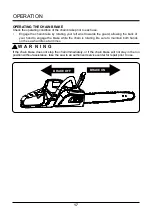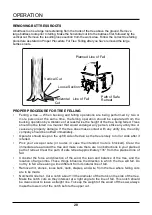
7
CAUSES AND OPERATOR PREVENTION OF KICKBACK
W A R N I N G
Kickback may occur when the moving chain contacts an object at the upper portion of the tip of the
guide bar or when the wood closes in and pinches the saw chain in the cut. Contact at the upper
portion of the tip of the guide bar can cause the chain to dig into the object and stop the chain for
an instant. The result is a lightning fast reverse reaction which kicks the guide bar up and back
toward the operator. If the saw chain is pinched along the top of the guide bar, the guide bar can
be driven rapidly back toward the operator. Either of these reactions can cause loss of saw control
which can result in serious injury. Do not rely exclusively upon the safety devices built into the saw.
As a chainsaw user, you should take several steps to keep your cutting jobs free from accident or
injury.
Kickback is the result of tool misuse and/or incorrect operating procedures or conditions and can be
avoided by taking proper precautions as given below:
1. Maintain a firm grip, with thumbs and fingers encircling the chainsaw handles, with both
hands on the saw and position your body and arm to allow you to resist kickback forces.
Kickback can be controlled by the operator, if proper precautions are taken. Do not let go of the
chainsaw.
Rotational
Kickback
Kickback
Danger Zone
2. Do not overreach and do not cut above shoulder height.
This helps prevent unintended tip
contact and enables better control of the chainsaw in unexpected situations.
3. Only use replacement bars and chains specified by the manufacturer.
Incorrect replacement
bars and chains may cause chain breakage and/or kickback.
4. Follow the manufacturer’s sharpening and maintenance instructions for the saw chain.
Decreasing the depth gauge height can lead to increased kickback.
IMPORTANT SAfETY INSTRUCTIONS
Summary of Contents for CS60L00
Page 40: ...40 EXPLODED VIEW ...








































